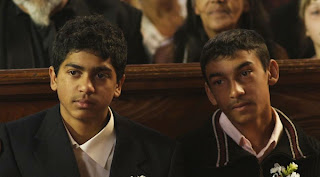Hamlet in Slovakia
“Gypsy” opens on Wednesday, June 27 at Film Forum.
Running time: 100 minutes; in Romany and Slovak w/English subtitles.
The depiction of a foreign culture is inevitably complicated by an audience’s outside perspective. In most cases, it’s not quite enough for a filmmaker to present foreignness with objective accuracy, because the audience already has preexisting stereotypes and expectations of how things should be represented. However, some of the most interesting depictions of foreign cultures can juggle and conflate stereotype with reality, following the idea that, for example, most audiences imagine space aliens to have green skin and large heads. Martin Šulík’s new film “Gypsy” seems to have a constant self-awareness of Romani (gypsy) stereotypes, and aims at dissolving them—or at least portraying them fairly—with sympathetic and ambivalent characterizations. The Romani have been living in Europe since sometime around theEleventh Century, but they’ve never fully integrated, and have retained their own social and cultural identities, while remaining somewhat enigmatic and distinctly foreign to most of the people they live amongst.
Rather than becoming a strict documentary of Roma life, “Gypsy” takes on the mood of a Shakespearean tragedy—but set in a Slovak village that’s decorated with rusted cars, stray dogs, and shanty houses. Within the first ten minutes, the father of fourteen-year-old Adam (Jan Mizigar) turns up dead; his mother remarries her dead husband’s brother, a sleazy thug named Zigo (Miroslav Gulyas); and Adam begins receiving visits from the ghost of his father, who somewhat vaguely suggests that Zigo was his murderer. Šulík applies the great lesson of neorealism—that the best way to depict the struggles of a people is by depicting the struggles of one person at a time. (And on another note, Šulík also used nonprofessional Roma actors.) The rest of the film is largely about the irresolvable conflicts surrounding Adam, who becomes a sort of cipher for all of the struggles of the Romani in general. Adam likes boxing, likes spending time with his neighbor girlfriend Julka (Martina Kotlarova), and seems to want a better life for himself.
He is thoughtful and impressionable, and all of the other characters see this in him—as a sort of blank slate that they can help, train, use, or influence. Zigo, the loan shark and petty criminal stepfather, wants to makes Adam his apprentice; the parish priest and boxing instructor (who’s perfectly epitomized in a shot of his office wall, on which hangs a picture of the pope next to a photo of Mohammed Ali) wants to save Adam by finding him a job and keeping him from stealing; a well-meaning ethnomusicologist visits the village, befriends Adam, and tries to convince him to enroll in engineering school on a scholarship; and the ghost of his father advises him on how to live an honorable life, but also vaguely suggests that he should avenge his death by murdering Zigo. Faced with this overwhelming confluence of choices and influences, which are all seemingly incompatible with one another, Adam stoically runs from one obligation to the next, unsure of whom to trust, and building up to the film’s implicit statement of “you wouldn’t know what to do either.”
Alongside Adam’s desperate need to choose how to live, most of the other Romani from the village want their lives to be different, too—from a nameless youth who’s kicked out of boxing training for sniffing glue, to a Roma that wants to move to England so that he might be mistaken for a Pakistani. In the end, the film doesn’t really pass judgments or suggest easy solutions. Even Zigo, who’s more or less the villain of the story, seems to be justified—at least partially—in his petty crimes, as a sort of Roma martyr who personifies the “us versus them” attitude. At times, the sheer density of these sympathetic yet tragic portraits is pretty overwhelming—something like being in small room crowded with too many interesting people.
But by characterizing the Romani with stark, sympathetic contrasts—as both thieves and victims, pariahs and martyrs—and by trying to give each person unique and ambivalent motivations, “Gypsy” offers a complex and fascinating portrait of Romani life

No comments:
Post a Comment